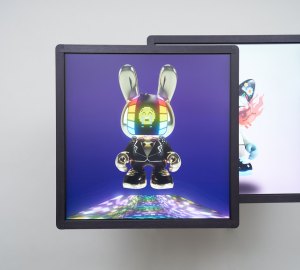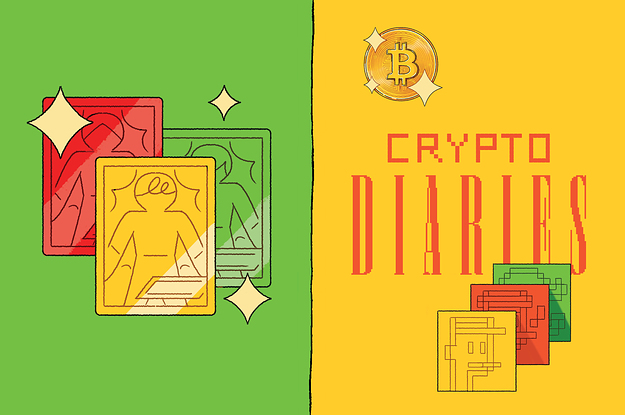“The auction room, as anyone knows, is an excellent medium for sustaining fictional price levels, because the public imagines that auction prices are necessarily real prices.”—Robert Hughes, 1984, The New York Review of Books
On March 11, 2021, Mike Winkelmann, a digital artist who goes by the online name, Beeple, auctioned off a digital work of art at Christie’s, one of the largest fine-art auction houses in the fine-art world. The title of the work was called, “Everydays: The First 5000 Days,” which was a collage of computer illustrations.
It sold for a staggering $69 million.
Why so much money? It’s a good question that’s difficult to answer. Aesthetically and visually speaking, Beeple’s work isn’t very original or interesting. New York magazine’s art critic, Jerry Saltz tweeted about the work, as well, “I looked up Beeple; just really really derivative Sci-Fi and Conan and Star Wars crapola as far as imagery and imagination go.” That’s not really a vote of confidence. It’s also not that Beeple’s work was the first digital work of art ever made. Digital artwork dates back to the 1990s, even before.
One reason Beeple’s work sold so high was because it included an NFT, or non-fungible token. NFT is an online digital format invented in 2014. An NFT is a digital certificate or digital file that’s connected to a blockchain, basically an online ledger. Blockchain technology also enables cryptocurrencies like Blockchain and Ethereum.
Part of what made the sale so remarkable is that worlds of fine art and digital media always had a frought relationship. This was particularly true when artists or gallery dealers try to sell digital art, which in some cases might be completely digital. Is the artist or gallery selling digital files? Or just the code of a website? And how exactly is it unique?
Photo courtesy of Nataworry Photography
Nevertheless, in 2021, many inside and outside the fine-art world seemed to be betting on NFTs, and by default, crypto, which is what NFTs are based on. The technology solves these and several other problems associated with digital media, by allowing cryptocurrency to digitally authenticate works bought online. NFTs solves the “unique” problem.
By chance or design or misunderstanding, sale of Beeple’s digital work ushered in a brief golden age of robust buying and selling of NFTs. It was a gold rush, of sorts, to buy NFTs: In December of 2021, Artnews reported that digital artist, Pak, sold a group of NFTs for $91.8 million, which may arguably be the highest price ever paid for a work by a living artist. This past March, the New York Times reported that $44 billion had been spent on NFTs. There was even a new museum dedicated solely to NFTs that opened this past April in Seattle.
Digital art seemed to have come of age with the minting of NFTs.
Then, in May and June of 2022, cryptocurrency prices crashed. The effects of that downturn reverberated in the NFT markets, according to many news outlets. According to Reuters, NFT sales were down sharply in the third quarter of 2022, to $3.4 billion from $12.5 billion at the market’s peak in the first quarter of this year. Bloomberg reported that trading volumes of NFTs are down 97 percent from January of this year, a record high. News outlets also connected the drop in NFT prices to the larger crypto crash. According to Bloomberg, “The fading NFT market is part of a wider, $2 trillion wipeout in the crypto sector.”
But that wasn’t the only bad news NFTs were getting.
In mid-October, Bloomberg published a massive 40,000-word story in Businessweek, written by finance writer, Matt Levine, who attempted to demystify and explain cryptocurrency as well as NFTs. But one might say that both crypto and NFTs got quite a harsh critique in Levine’s story: For example, in the middle of the article, Levine refers to an Esquire article, which discusses how some in crypto are trying to reimagine books as investment opportunities! Levine’s take is this? “The bad way to put this is that every web3 project is simultaneously a Ponzi.”
Levine also questions the thin connection between the code you’re investing in on the blockchain when you buy an NFT and the actual piece of art. He writes, “but what does it mean to say that the NFT is a piece of digital art? The art does not live on the blockchain…. If you buy an NFT, what you own is a notation on the blockchain that says you own a pointer to some web server.” It’s like paying a museum for a Cezanne, and they only give you the page from the museum catalog…or better yet, they’ve only sent you the museum wall label!
On Bloomberg TV, Pat Regnier, Finance editor at Bloomberg Businessweek who edited Levine’s story, said there are other aspects of NFTs to be skeptical about, “I think we’ve all observed that there were enough shenanigans in that [fine-art] market—of creating inflated valuations—[which may give] people a lot of pause about getting into that space.” Perhaps he was referring to Pak or Beeple.
Legally speaking, there are other troubling questions. “The intellectual-property rights to that picture of a monkey,” writes Levine, “are certainly none of the blockchain’s business. It’s not uncommon for the person or company selling the NFT series to 1) own the IP rights to the pictures of the monkeys and 2) promise to transfer those rights, or some of them, to individual holders of the NFTs. But if that happens, it happens off the blockchain; those promises are or aren’t enforceable through the normal legal system.” In effect, buying an NFT might not really solve the problems people expect them to.
For Renier, a rather chilling financial takeaway from Matt Levine’s story is that many within the crypto world have created digital processes and apps that have been repeating the mistakes made in the economic crash of 2008: “People who are building these structures are building things that look a lot like the things in traditional finance that break, and sometimes break disastrously.”
So, NFT investors might want to keep an eye out: It may not just be a very harsh crypto winter that they have to suffer through, but a crypto Armageddon.
The post The Rise and Fall of NFT Art appeared first on Worth.
Changpeng Zhao of Binance says he plans to help struggling digital asset firms. It is a stunning role reversal for Zhao and FTX CEO Sam Bankman-Fried.
For an industry built on the principle of decentralization, we had a lot of trust in one 30-year-old. Understanding why is key to a more sustainable future for crypto.
The parent company behind Bored Ape Yacht Club adds to its growing portfolio of popular non-fungible (NFT) projects.
(Bloomberg) — Coin Cloud has tapped M-III Partners and B Riley Securities to help rework about $125 million of debt that the operator of Bitcoin automatic teller kiosks accumulated during a period of aggressive growth, according to people with knowledge of the situation.Most Read from BloombergFTX’s Balance Sheet Was BadChina Plans Property Rescue in Latest Surprise Policy ShiftBiden, Xi Chart Path to Warmer Ties With Blinken China VisitMusk Publicly Punishes Twitter Engineers Who Call Him Out
Crypto exchanges are rushing to reassure customers of their solvency as traders continue to pull money out of crypto.
It’s been a rough year for NFT (non-fungible token) investors. As the 2022 tax year comes to a close, NFT traders may hope to tax-loss harvest, or sell their assets at a loss in order to offset current or future capital gains. There are many reasons NFT tax-loss harvesting is a challenge.
Most other major cryptos were trading in the green, albeit barely so. Market Wrap is CoinDesk’s daily newsletter diving into what happened in today's crypto markets.
Dell Technologies (DELL) doesn't possess the right combination of the two key ingredients for a likely earnings beat in its upcoming report. Get prepared with the key expectations.
A rise in Bitcoin prices is the most important factor for a significant increase in the number of new investors, instead of distrust in public institutions, dislike for traditional banks, or search for a store of value, according to a report by the Bank for International Settlements.
NFT platform laCollection has launched a series of collaborations with international artists to raise funds for Ukrainian cultural institutions.
Interior design expert, Grace Lee, shows us how to create our own DIY statement wall on a budget. The post Follow these easy steps to create your own statement art wall appeared first on In The Know.
STORY: Location: New YorkStep inside the ‘Museum of Broadway’ which shows the history and making of Broadway shows From ‘The Phantom of the Opera’ to ‘The Lion King’ or ‘Wicked’[Diane Nicoletti, Co-founder / Museum of Broadway]“So, it took us five years to create the museum and it took several of those years coming up with the concept."[Julie Boardman, Co-founder / Museum of Broadway]“It's sort of one of those hidden obvious is like, why does it (Museum of Broadway) not exist? Broadway's been around, you know, since the 1700s. And so we just are really wanting to bring that to life, to show people to, you know, a lot of the timeline as you're walking through this immersive timeline of Broadway, you're getting this sense of, you know, basically the art that we have today wouldn't be possible had all of these other people not paved the way and broken ground and pioneered and really changed the landscape of Broadway. It's a very uniquely American art form that's developed here. And so, you know, it should be here, and it should be in Times Square. And, you know, we kind of pinch ourselves that we're the ones doing it, but no one ever did. So here we are.”The Museum is situated in the middle of Times Square and consists of three parts[Diane Nicoletti, Co-founder / Museum of Broadway]“Three parts, we have the map room that tells the history of how the theater district came to be. And so, it used to actually be in the financial district, and it migrated north to present day Times Square. We have the timeline of Broadway, where we have exhibits of game changing and groundbreaking shows, as well as the actual timeline of Broadway. And then we have the making of a Broadway show, which is all of the behind-the-scenes roles that actually make a show come to life.”The Museum of Broadway opens on November 15, 2022
‘If you insert a different color, if you insert a different race, it is wrong,’ interpreter said
Are CryptoPunks modern art? Yuga Labs believes so, and aims to solidify their historical legacy by placing the Ethereum PFPs within art museums.
Now that we know the Thunderbolts are coming to the MCU, here's what you need to know, who they are, and what their arrival means!
The donation is the first in the company’s Punks Legacy Project which aims to install CryptoPunks in contemporary art museums worldwide.
The comic book has gone where no other has before.
When The Lion King opened on Broadway 25 years ago, it immediately proved to be a critical and commercial success. This adaptation of the 1994 Disney film was boosted by the visionary brilliance of director Julie Taymor who, after some tricky discussions with studio executives, was allowed to play fast and loose with the original. One of Taymor’s many innovations was inspired by Japanese Bunraku-style puppetry which allowed the audience to see the actors, with animal masks on their heads evoking
Riri "Ironheart" Williams is coming to the MCU in Black Panther: Wakanda Forever and Ironheart. Here's what you need to know about her.
It's one reason to be concerned about consumer spending, especially during the holiday shopping season.


